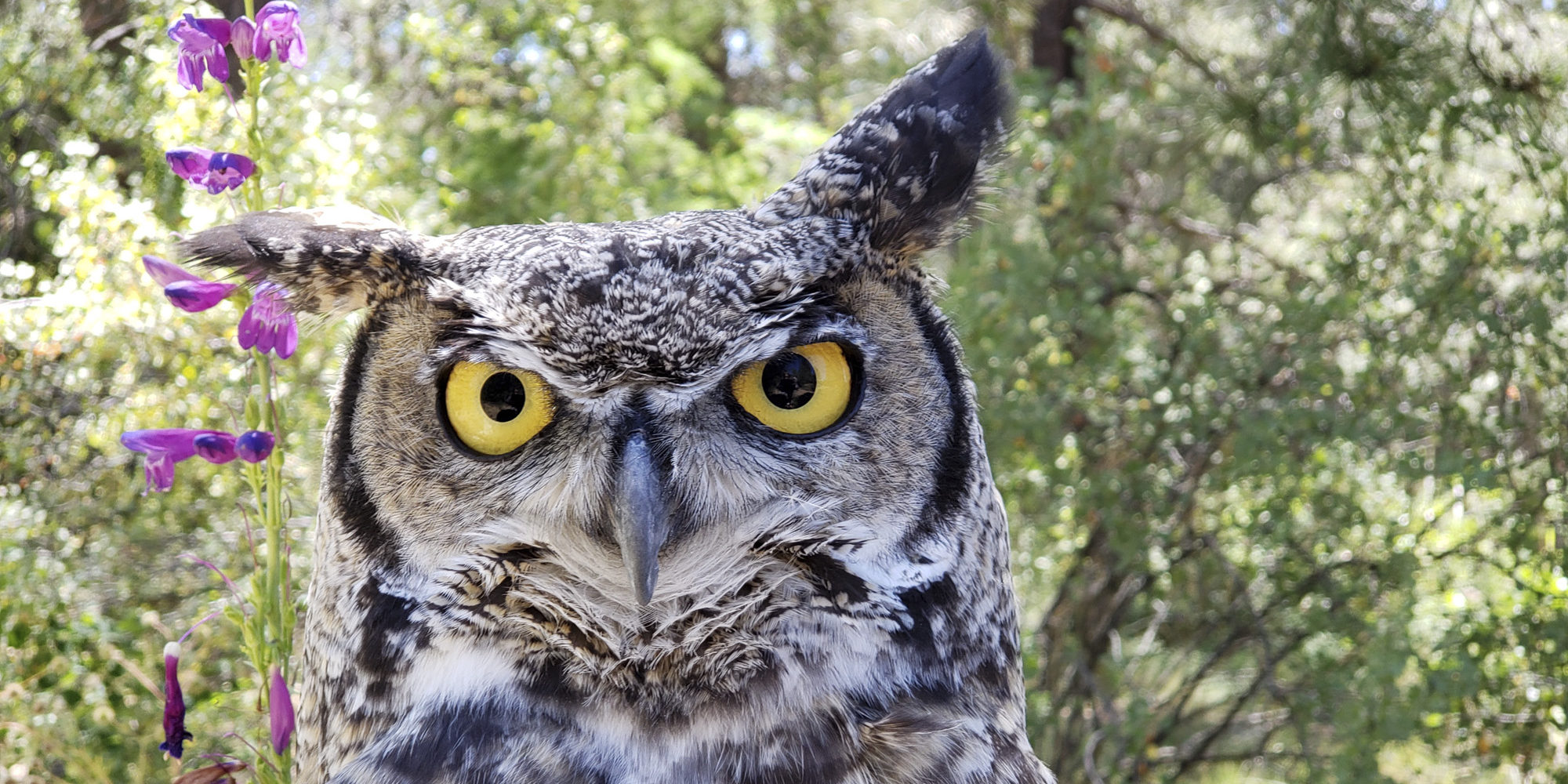By Amanda Accamando, Nature Center Manager
It is safe to say that all of us at Sunriver Nature Center & Observatory are enthusiastic about owls; just see our logo above. Our organization has served as a home to a variety of species over the years and hundreds of owls, mostly Great Horned Owls, have come to our center for rehabilitation over the years.
The United States is home to 19 species of owl and 14 of those can be found in Oregon. Some of the species are very common – like the Great Horned Owl, whereas others are rare or uncommon, such as the Snowy Owl who infrequently drifts down into Oregon during the winter months but is more likely to be found in Washington. Of those 14 owls, five are considered Oregon Conservation Strategy Species by the Oregon Department of Fish and Wildlife and one, the Northern Spotted Owl, is federally listed as an endangered species.
Owls are endlessly charismatic and intriguing – from their large piercing eyes, their impressive neck rotation, to their extraordinary hunting skills and silent flight. Oregon’s owls are a diverse cast of characters. There are owls that migrate (Flammulated Owl) and those that nest underground (Burrowing Owls). There are a few species that weigh just a few ounces (Boreal Owl and Northern Pygmy Owl), whereas a Great Horned Owl can weigh over three pounds. Although there are certainly owls that are nocturnal, many are considered crepuscular (most active at dawn and dusk) with the notable Northern Pygmy Owl primarily diurnal (active during the day).
In Sunriver, we reliably see or hear at least three species of owls – the Great Horned Owl, Great Gray Owl and the Western Screech Owl. The Western Screech Owl, a diminutive owl that nests in tree cavities, is often heard in our area but can be much more difficult to spot. Great Horned Owls are one of the most commonly encountered species, not only in Oregon, but throughout North America. They are a superb generalist predator feeding on a wide variety of prey including small rodents, frogs, scorpions and even other birds. By contrast, the Great Gray Owl, another inhabitant of our mixed conifer forests, has a more specialized diet feeding mainly on voles and pocket gophers and seeking out marshland for hunting. Great Gray Owls lack the distinctive ‘horns’, called plumicorns, of the Great Horned Owls, but are distinctive for their pronounced facial disc and large size. Although the Great Gray Owl is the largest species of owl in the world by height, they are mostly fluff and weigh less than a Great Horned Owl. If you look at a range map of the Great Gray Owl you will see that they primarily occupy the northernmost reaches of Canada. However, a small pocket of their range extends through the Cascades allowing us the opportunity to see this spectacular species on a regular basis in Sunriver.
February and March are a great time to head outdoors to study and search for owls. However, if you set out with a goal to see an owl, you may return home disappointed. You will be much more successful if you adjust your expectations and set out at dusk to listen for owls. During the mating, nesting, and fledgling season for owls which takes place in later winter through late spring, you are likely to hear owls calling to one another. Owl vocalizations, such as the Great Horned Owl’s hoot, are used in communication between males and females for courtship and to advertise territory among pairs. The calls of the Great Horned Owl, Great Gray Owl, and Western Screech Owl are all very distinct, and can be confidently identified even by beginners with a little practice. Before you head out, you can listen to a few sample calls on your favorite birding app or on YouTube, however it is important to not play those calls while out in the field birding during the mating season. Later in the spring, listen for calls from the nest as young owls beg for food. If you happen to hear an ear-piercing scream in the middle of the forest you may be able to follow it to a nest or spot a branchling – a young owl who is fledging but still remains close to its parents for the occasional meal.
Sunriver is rich with great habitat for owls. In addition to the three commonly encountered species, birders have also spotted Barred Owls, Short-eared Owls, and Long-eared Owls in our area. With a little patience and perseverance, owls can become less elusive. Of course, there is one place you can reliably see owls in Sunriver – the nature center. You can visit Joe, our resident Great Horned Owl, and Luna, the Eurasian Eagle-owl, daily if you need an owl fix. Or make a reservation and join us for a Raptor Tour on Fridays, Saturdays, and Sundays at 11am throughout the winter to learn more about the owls, and other resident birds of prey of the nature center. Last, but not least, we look forward to resuming our Saturday Bird Walks this spring led by expert birder, Tom Lawler – our inside source for all Sunriver’s feathered residents. Whether you are birding on your own or with us, we always recommend reviewing the American Birding Association’s Code of Ethics from time to time for a reminder on how to practice respectful and thoughtful birding so that future generations can enjoy these same wonders.

